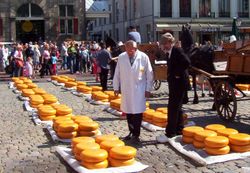Gouda Cheese

From the Wikipedia:
Gouda is a yellowish Dutch cheese named after the city of Gouda. The cheese is made from cow's milk that is cultured and heated until the curds separate from the whey. About ten percent of the mixture is curds which are pressed into circular moulds for a couple of hours. The moulds give the cheese its traditional shape. Next, the cheese is soaked in a brine solution which gives the cheese its rind and improves the taste. After the salt soaks in, the cheese is then dried for a couple of days before being coated to prevent it from drying out. It is aged for at least a couple of weeks before it is ready to be eaten. The term "Gouda" is now a generic name, and not restricted to cheese of Dutch origin. The term "Noord-Hollandse Gouda" is registered in the EU as a Protected Designation of Origin. The peculiar thing about this is that the city Gouda is located in the Dutch province Zuid-Holland. However, Gouda-type cheeses from Noord-Holland have a better reputation for their quality.
Exported Gouda is usually the young variety (aged between 1 and 6 months, rich yellow in colour and with a red or yellow paraffin wax coating). This cheese is easily sliced on bread with a cheese slicer. Exported Gouda has a pungent underlying bitterness, yet is still considerably creamier than other common cheeses, such as cheddar cheese, edam cheese. Locally, old Gouda (aged between 12 and 18 months, orange-yellow in colour and sometimes discernible by a black paraffin wax coating) can be obtained. This strong tasting cheese is hard and often too brittle to cut using a slicer, but it can be sliced by knife or served cut in cubes with drinks. Smoked Gouda is also a common find in many cheese markets and mega-marts.

No comments:
Post a Comment